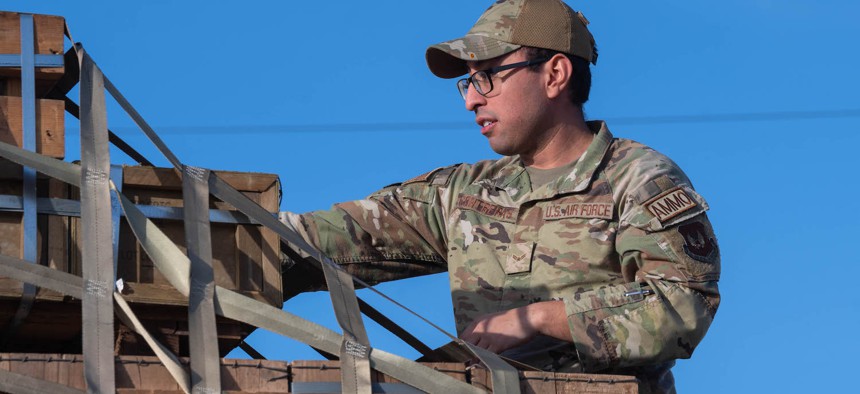
Airman 1st Class Daniel Contreras, 86th Munitions Squadron stockpile management crew chief, examines pallets of munitions on a truck at Ramstein Air Base, Germany, Jan. 25, 2024. U.S. Air Force / Airman 1st Class Trevor Calvert
To rebuild America's arsenal, rehabilitate the National Defense Stockpile—and prioritize critical munitions
Our munitions stockpiles and production capacity are not just inadequate; they are a glaring vulnerability.
To arm American allies and partners—and ensure U.S. armed forces can deter and fight a major theater war—the United States must rehabilitate the largely obscure National Defense Stockpile and focus on critical munitions. Based in Fort Belvoir, Virginia, with operations throughout the United States, the stockpile holds an emergency supply of 50 critical minerals. Many, such as aluminum, titanium, magnesium, and electric steel, are used in the production of munitions, and this is where the heaviest focus should be placed.
A critical munitions reserve within the national stockpile would restore essential munitions stocks vital for maintaining air dominance, conducting interdiction operations, defending against air and missile threats, and targeting hard and deeply buried objectives. Consequently, this repository should include Long Range Anti-Ship Missiles, Precision Strike Missiles, Extended Range Joint Air-to-Surface Standoff Missiles, and 155mm artillery shells.
The stockpile would help sustain American industrial output in times of crisis and preserve the United States' global military edge. Right now, the cupboard is nearly empty.
Ukraine is depleting Western reserves
Washington’s aid to Ukraine, whose forces are firing more than 6,000 artillery rounds a day, includes munitions pulled from the Pentagon’s stock. But as many have noted, this draws down high-end munitions the U.S. would desperately need in a conflict with China. In such a war, the Center for Strategic and International Studies recently concluded, the U.S. would likely burn through its munitions within three weeks and would be unable to replenish those stocks for more than six months.
A limiting factor in wartime replenishment would be supplies of critical materials. Should a war break out with China, the United States would quickly burn through its stocks of rare earth elements. The situation would be even worse if China has used its near-monopoly on rare earths to further constrict the flow of these vital materials to U.S. weapons manufacturers. The United States stockpile of dysprosium and europium, used in several missiles classes, are completely empty. Worse, the United States has almost no ability to domestically manufacture vital strategic materials, while the intricate supply chain for rare earth elements has predominantly shifted beyond its borders.
To meet the challenge, it’s time to revive the Cold War relic of the National Defense Stockpile. Valued at $42 billion in 1952, the value of materials in stockpile has drastically decreased to less than $1 billion today. Moreover, America's mineral reserves are far lower than China's, with the U.S. maintaining only 300 metric tons of cobalt to China's 7,000 metric tons.
In preparation for prolonged conflicts and unpredictable market fluctuations such as delays in domestic refining projects, it is imperative that the stockpile holds adequate reserves of critical minerals to cover three years of U.S. demand. The U.S. government recognizes 50 minerals as "critical," necessitating the stockpile to be equipped for potential wartime scenarios and the subsequent replacement of military resources within three years after a conflict.
The Defense Logistics Agency should prioritize stocking critical minerals most necessary for the munitions of likely use in a U.S.-China conflict—again, LRASMs, PSMs, JASSM-ERs, and 155mm artillery shells.
But the critical munitions stockpile not only needs more in it, it needs more of it. Amassing such extensive reserves, especially for high-consumption minerals like aluminum, presents logistical challenges given the limited storage facilities. The current National Defense Stockpile is held in a paltry six depots, most of which are full or near-full. During the Cold War, however, the U.S. managed 102 depots containing 92 critical materials. Expansion to these levels is not necessary, but the Defense Logistics Agency must build out more storage infrastructure.
The PROCURE Act, introduced by a bipartisan group of senators, would go a long way toward building this stockpile, by establishing a $500 million per year revolving fund in the Treasury Department for the Pentagon to procure critical munitions. This fund would allow the Defense Department to swiftly replenish high-demand munitions supplied to partner countries in future conflicts, using profits from the U.S. Foreign Military Sales program.
Our munitions stockpiles and production capacity are not just inadequate; they are a glaring vulnerability in our national defense strategy. We must act with resolve and urgency to revitalize our defense industrial base and expand our reservoir of munitions-production minerals. Nothing less than our national interests and global stability are at stake.
Joe Buccino is a retired U.S. Army colonel. He served as the communications director for U.S. Central Command from April 2021 to July 2023.